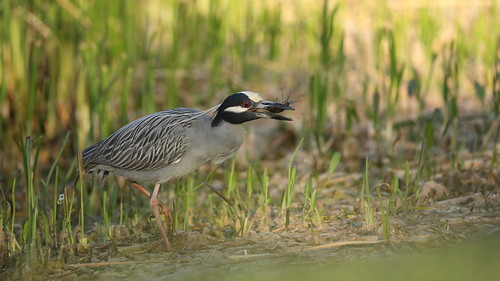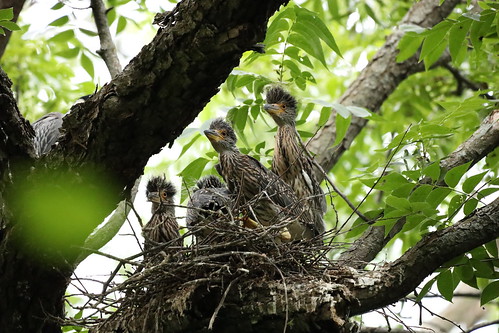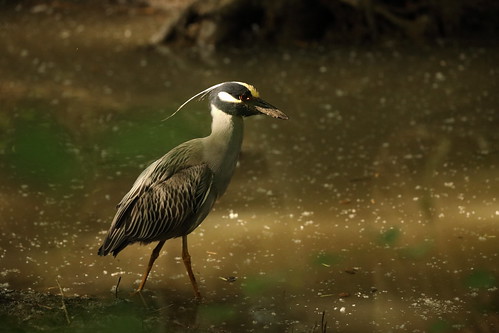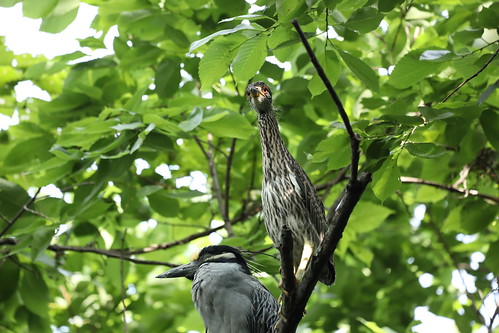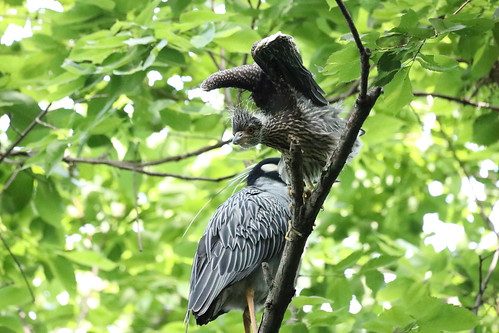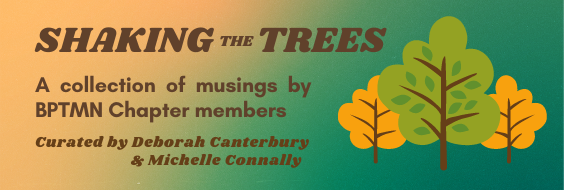John W. Garbutt, Class of 2019
On May 1st I set out to observe the herons hunting along the edge of the pond. I anticipated that with mouths to feed in the colony, I would find a lot of heron activity at sunrise. I laid on the ground using a Bald Cypress as a blind and its roots as a tripod as I awaited a heron to work its way toward me.
As the Yellow-crowned Night-Heron flipped, tossed, and consumed its prey, I could not help but think of my favorite film and Quint describing the sharks attacking the crew of the U.S.S. Indianapolis.
Crayfish poppers, the meal of choice.
Yellow-crowned Night-Herons feed primarily on crustaceans. When in our area during breeding season and away from coastal areas, crayfish make up a majority of their diet. I’ve also witnessed them consume turtles and snakes. After watching the herons consume a few crayfish, it was time to visit the colony. Upon entering the colony, one of the herons was snapping branches above the trail to complete construction of Site E.
Final materials for completing the fifth nest.
Heron showing its extra eyelid, the nictitating membrane.
A couple of weeks later on a warm and humid afternoon, I visited to check the status of the hatched birds. I was anticipating being able to see them soon; the young remain in the nest approximately 30-43 days. Before observing the nests, I found a few herons hunting and attempting to cool down through gular fluttering.
“Fluttering” the excess heat from the body. Little did we both know, the humidity was going to remain and worsen over the next two months.
I could hear the hatchlings from Site C as I neared the main concentration of nests. Though I could not see them yet, their mother was tending to an undetermined number of young. As I attempted in vain to see them, a newly arrived sixth pair of herons grabbed my attention. The male was quite vocal. I could tell by their plumage that both were very young and that I had not seen them before. Yellow-crowned Night-Herons obtain adult plumage between three and four years of age. This pair must have been entering their first year of sexual maturity. I continued to hear courtship calls the following week but never located this pair or an additional nest.
By mid-May, the first hatchlings had become larger nestlings: visible above the rim of the nest, alert, and curious. When food arrived, the five nestlings of Site A raised their crowns in excitement.
I also noticed a couple of herons make their way from the concrete path down to the creek. In ten years, I had never seen them hunting there before. Perhaps, the large concentration of herons had forced them to expand their hunting territory. This spot happened to be at one of the hawk nest viewing points. I moved slowly to the edge of the creek and sat between two logs using one to brace my shots and to obscure the heron’s view of me.
The canopy above diffused the brightness of the rising sun, creating a softer light on the murky water below. More direct shafts of light created brighter golden spots highlighted by sparkling willow tree sheds. This reflected a golden aura on the heron which was highlighted by two shafts of light hitting the front of the beak, and the white ear patch and red-orange eyes. My friend Zoe who has helped me with photography stated, “…the lighting [was] like a fine art portrait painting.”
Profile view shot at 600mm.
Shot at 215mm to capture the atmosphere around the heron.
The calendar had turned to June. The nests had begun to empty. The first two nests to hatch combined to produce nine fledglings. Because of the foliage’s thickness I never got a definitive count of the other three nest. The last time I saw the family of Site C together was an interesting experience. The four young were dispersed around the nest. Their mother rested amongst them. One of the fledglings raised its crest which grabbed my attention. The father landed and flashed his plumes announcing his arrival to his family. To the dismay of the fledgling, it was not a food delivery. Instead, the adults began reinforcing the nest. I was curious about this behavior. Why would they do this? Did the fledglings return to roost in the nest at night? Or did it help maintain the adults’ bond to finish rearing their young?
Mother and child.
Exercising the wings.
I next stopped to examine the Cooper’s Hawk nest which I had not observed as much this year. I heard the sound of large wings cutting through the air behind me. My first thought was an adult hawk was encouraging me to leave the area. However, it was one of the herons landing in a tree which overhung the creek. I hoped to capture a photograph of it in the shafts of light. However, the sun was too high and past my favorite lighting period. So I lowered the camera’s ISO to emphasize the light shaft hitting the bird’s face through the darkness of the canopy above. I was quite happy with the results.
I tend to refrain from anthropomorphism but it was hard to not feel that this adult arrived at the opposite end of the creek from the colony to catch a nap in-between parenting duties.
On the 18th, I saw the immature herons away from the nests and at the pond for the first time.
Looking over the pond at sunrise from a tree along the edge line.
Final Observations and Thoughts on a Yellow-crowned Night-Heron Colony
Three months to the day after the initial discovery of the herons, six of their offspring were hunting along the pond. I laid down at their vantage point to observe these birds, about two months old, as they set out on their own. The flock of four nearest me patrolled the shore line, occasionally flapping their wings at the cottontails in their path. Not yet having the patience of their parents at the water’s edge, they moved a few feet inland and struck out at rocks, sticks, and plastic bottle caps, sharpening the skills that would perhaps one day return them here to have their own young.
Three of the group of four.
As a Southwest Airlines jet flew over, one of the herons looked skyward and traced the jet as it flew south. This, a route similar to the one the heron will embark on for the first time this fall. One of the young began approaching me as I lay in the shade of the Bald Cypress. With my eye in the view finder, I saw the unique head-on profile of a heron causing me to feel like prey. Soon the young heron was within about three feet. It was too close to focus my camera. It was hard to tell who was most curious about the other as we locked eyes. Eventually it made its way around me.
Close encounters of the heron kind.
I examined the colony for perhaps last time and located one fledgling and three nestlings in the last nest. Perhaps the others had already disbursed or did not make it. It felt like it had been an eternity observing them over the course of my visits to the colony, though it had only been three months.
How quickly it passed.
John W. Garbutt
Class of 2019




